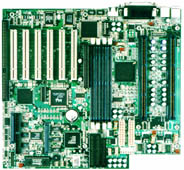RIOWORKS XDG-LS Dual Slot-2 GX
by Anand Lal Shimpi on June 16, 1999 5:27 PM EST- Posted in
- Motherboards
Just three months ago, the not nearly saturated motherboard market was blessed by the entrance of a new comer to the industry, RIOWORKS. March 16, 1999 marked the introduction of the company in Hanover, Germany during this year's CeBIT convention. Since then they have made a single appearance on AnandTech, while the review of RIOWORKS' PDB-S wasn't a stellar one, it did point out RIOWORKS' strengths and weaknesses.
As a follow-up, AnandTech will be taking a look at a higher end solution from RIOWORKS, the dual slot-2 Xeon XDG series is intended to extend RIOWORKS' low-cost, high performance philosophy by bringing the power of the Intel Xeon processor to the hands of smaller businesses and high end users on a budget with a "low" cost Xeon board.
With most Xeon boards starting at around the $500 - $600 mark, a low cost Xeon board would translate into something closer to the $300 - $400 mark. While the XDG-LS AnandTech reviewed didn't quite cut it in terms of price, it is a motherboard that can most likely be found at a cost somewhat lower than competing Xeon solutions. But how good is the board itself? Let's take a look at the basic specifications first...
| CPU Interface | Dual Slot-2 |
| Chipset | Intel 440GX |
| On-Board Video | N/A |
| L2 Cache | N/A (on-chip) |
| Form Factor | Extended ATX |
| Bus Speeds | 100 |
| Clock Multipliers | 4.0x - 6.0x |
| Voltages Supported | 2.0v/2.8v (Auto Detect) |
| Memory Slots | 4 168pin DIMM Slots |
| Expansion Slots | 1 AGP Slot 0 AMR Slot 6 PCI Slots (5 Full Length) 1 ISA Slots (1 Full Length) |
| BIOS | AMI BIOS |
The Good
| The extended ATX form factor of the XDG-LS is necessary to make room for the 6/1/1 expansion slot configuration (PCI/ISA/AGP) the board boasts. Reminiscent of Tyan's Thunder 100, the XDG-LS aligns all the expansion slots, memory banks, and processor slots in parallel with each other making sort of an unofficial "reference design" for dual slot-2 Xeon motherboards. The layout of the XDG-LS makes enough room for 5 of the 6 PCI slots (the 6 are courtesy of the Intel 21152 PCI-to-PCI bridge) to be able to accept full length cards, often times a requirement with high end workstation and server motherboards. The only remaining, albeit shared, ISA slot is also capable of accepting a full length card. | |
| Finally, the AGP slot is also capable of accepting a full length card, and lies adjacent to the last of 4 DIMM slots on the board. The 443GX controller chip that is covered by the green heatsink on top of it is what allows the XDG-LS to accept and support a total of 2GB of system memory. This is a function of the chipset, and an improvement over the 1GB limitation of the Intel 440BX chipset. | |
As with all dual Xeon boards, the two SC330 (slot-2) connectors are placed extremely close to one another and are then placed very close to the 443GX chip in order to decrease trace lengths between these critical components of the motherboard. The board does ship with a SC330 CPU terminator card in the event that the motherboard will operate in single processor mode only, and features the massive Xeon CPU retention kit as well. The board only supports the 100MHz FSB and clock multipliers ranging from 4.0x to 6.0x. As with all desktop Intel CPUs, the Xeons are clock multiplier locked, meaning that as long as there is BIOS support for faster 100MHz FSB Xeon processors the XDG-LS will support them. Unlike most other Xeon motherboards, the XDG-LS is a jumperless solution which makes the installation and configuration of the board even easier than most boards already are. A definite plus as any system admin will have bigger things on his/her mind than where the heck JP3 is on a motherboard.
The RIOWORKS XDG is available in three flavors, the XDG-L, XDG-S, and the XDG-LS which was the sample provided to AnandTech for review. The three boards are built on the same PCB, and are essentially the same board with the XDG-L featuring on-board 10/100 Ethernet, the XDG-S featuring on-board Ultra2 SCSI, and the XDG-LS featuring both on-board 10/100 Ethernet and Ultra2 SCSI. If you're going to be running the board as a stand alone workstation for CAD/Design, development, etc.. then you may opt to get the XDG-S which doesn't feature the on-board Ethernet controller. Or if you have your own 10/100 Ethernet controller the XDG-S will give you the on-board Ultra2 SCSI that you may be looking for. As a server, you may want to opt for the XDG-LS which has both the on-board Ethernet and SCSI adapters, as chances are that you'll be making much use of both of those features.











0 Comments
View All Comments